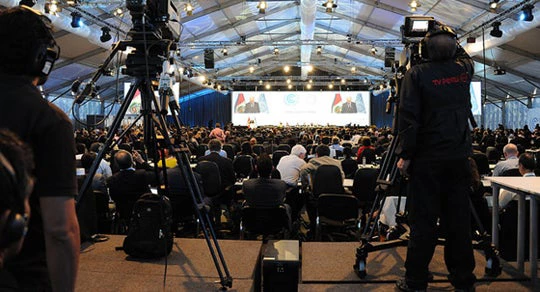Over the next few months, governments worldwide will be preparing their national contributions to our collective need to combat climate change. These plans will form the foundation of a new international climate agreement to be agreed in Paris in one year’s time. Collective ambition matters now more than ever. We all have a responsibility to make the choices that will lower the risks created by decades of greenhouse gas emissions and usher in an era of job-rich, more-inclusive, cleaner economic development.
Scientists have provided us with a remarkable consensus. We believe that with this evidence, we have the strong foundation for action. That’s good news, because climate action has to scale up now.
This week and next at the UN climate negotiations in Lima (COP20), there is a sense that gridlock may be easing. The U.S. and China – the world's two largest emitters – set a strong pace last month when Presidents Barack Obama and Xi Jinping stood together and jointly announced their top-line commitments for cutting emissions. Their pledges, along with commitments from the European Union and donor support for the Green Climate Fund, auger well for the Lima talks. But this was always billed as the finance COP, and how we finance the transition to deep decarbonization and lasting resilience requires a coming together that has eluded us to date.
At the UN Secretary-General’s Climate Leadership Summit in September, the discussion of how we finance climate action saw private sector groups moving forward and a focus on a number of subnational initiatives. At the same time, a remarkable coalition of 74 countries and over 1,000 businesses came together around pricing carbon. This coalition is now focusing its work. It will bring companies and governments together to learn from existing carbon pricing structures and find effective ways to encourage sustainable business decisions. It will focus on how globally networked carbon markets can emerge and how to get prices right.
That’s why we will be talking at Lima about how to put the right economic drivers in place and what countries need to include in their national contributions. If demand is strong, prices will be robust and then finance can flow.
In this context, we will continue to support the Green Climate Fund and, together with our colleagues in the other multilateral development banks, offer ways to direct its initial capitalization of $9.7 billion into highly leveraged, impactful mitigation and adaptation action. We will be talking about our commitments to measure and report and build common criteria for how we use development finance and climate finance to aid in making climate finance flows more transparent and therefore increase trust.
We will agree that the evidence is clear that we need to mainstream resilience into development and that we need an injection of new development finance to meet the clear needs of the most vulnerable to climate change.
Landscapes Day at the COP will take place Dec. 6-7. We’re delighted that the broader land-use communities are coming together. If the goal is clearly to decarbonize by 2100, then the way we manage landscapes and the value we place on nature and ecosystems will need to shift and soar to the top of the agenda.
We believe government policies, planning, and business practices can help rein in deforestation and improve land management practices. At the World Bank Group, we are helping countries to change from business-as-usual land use to climate-smart development that integrates forestry and agriculture. Results-based payments that provide additional value to countries that successfully reduce deforestation and forest degradation offer promising lessons. The programs that support working in these areas need to be more streamlined and better coordinated if we are to move to scale. We are excited by the number of countries that are poised to move forward.
We’ll be talking about all of these action areas in Lima, and focusing all of our conversations on the impact on the poorest people. Every piece of research we commission or complete tells us we must start now to build resilience into all development decisions.
Last week, we released the third report in the Turn Down the Heat series. The world is already 0.8°C above pre-industrial times, and we are seeing the impacts of climate change as glaciers disappear and extreme weather becomes more common. If we continue with business as usual, the studies suggest that today's teenagers will be left with a planet of more heat waves, droughts, rising sea levels, and loss of water and food security in many regions. It will impact their health, crops, and businesses, as well as livability. The costs will only continue to rise without action.
The evidence is sobering.
A few days ago, I was explaining the plot of the new movie Interstellar to my young son. After listening carefully to this tale of plundering of planet Earth, the failure of food systems and a space mission to find a hospitable environment in another galaxy, he turned to me and said, “so it wasn’t really science fiction then.” His reaction left me still.
We don’t have to get to the point of a dystopian world. There is a place for every country to start the transition to cleaner development, decisions that every policy maker can make, contributions that every country can make, and a collective responsibility to manage the global economy that global economic leaders need to assume now to spur momentum in the right direction.
Rachel Kyte
World Bank Group Vice President & Special Envoy for Climate Change
www.worldbank.org/climate
Twitter: @rkyte365
Photo: COP20 opens in Lima, Peru. Credit: UNFCCC



Join the Conversation